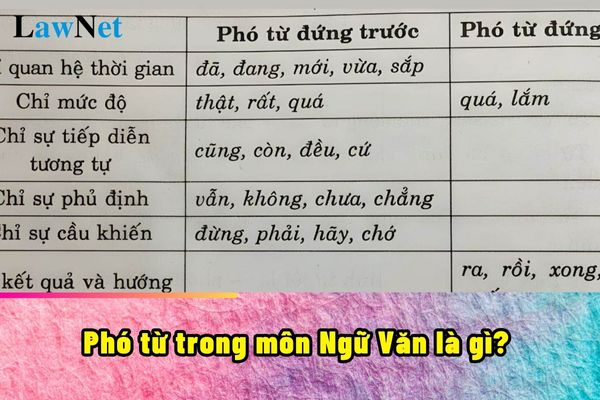What are adverbs in Literature curriculum in Vietnam? When do students in Vietnam learn adverbs?
What are adverbs in Literature curriculum in Vietnam?
Adverbs of Vietnamese are words that accompany verbs, adjectives, or other adverbs to supplement the meaning of those words. They make sentences more vivid, specific, and image-rich.
*Functions of adverbs:
Supplementing the meaning of verbs: Indicating the manner, degree, time, frequency, possibility, etc., of an action occurring.
Examples: đi chậm, nói rất nhanh, học hăng say, đã từng, sẽ đi.
Supplementing the meaning of adjectives: Increasing or decreasing the degree of qualities and characteristics.
Examples: rất đẹp, hơi buồn, quá nóng.
Supplementing the meaning of other adverbs:
Example: đi rất chậm rãi.
Classification of adverbs:
*Based on meaning, adverbs are divided into many types, but the most common ones are:
Adverbs of manner: chậm rãi, nhanh chóng, từ từ...
Adverbs of degree: rất, lắm, quá, hơi...
Adverbs of time: đã, đang, sẽ, chưa...
Adverbs of frequency: thường xuyên, luôn luôn, đôi khi...
Adverbs of possibility: có thể, có lẽ, chắc chắn...
Adverbs of affirmation or negation: đúng, không, chẳng...
*Examples of sentences using adverbs:
Anh ấy rất thông minh.
Cô ấy hát hay lắm.
Mẹ tôi đang nấu cơm.
Tôi đã từng đi biển.
*Note: The information is for reference only.

What are adverbs in Literature curriculum in Vietnam? When do students in Vietnam learn adverbs? (Image from the Internet)
When do students in Vietnam learn adverbs?
Based on Item V of the Appendix in the Literature subject of the general education program issued together with Circular 32/2018/TT-BGDDT stipulating the requirements for Grade 7 Literature:
VIETNAMESE LANGUAGE KNOWLEDGE
- Idioms and proverbs: characteristics and functions
- Terminologies: characteristics and functions
- Meaning of common Sino-Vietnamese elements (e.g., national, family) and the meanings of words containing those elements (e.g., national dignity, family situation)
- Context and the meaning of words in context
- Numerals, adverbs: characteristics and functions
- Main components and circumstantial components in sentences: expanding main components and circumstantial components with phrases
- Uses of ellipsis (cooperate with the comma, indicate many similar things not listed; show unfinished or hesitant, interrupted speech; slow down the sentence rhythm, prepare for the appearance of a word expressing unexpected or humorous, sarcastic content)
- Rhetoric devices of hyperbole, meiosis: characteristics and effects
- Text coherence and unity: characteristics and functions
- Text styles and genres
+ Narrative text: a composition recounting true events related to characters and historical events
+ Expressive text: an expressive composition; four-word, five-word poems; a paragraph expressing emotions after reading a four-word, five-word poem
+ Argumentative text: relationships between opinions, reasons, evidence; an argumentative composition about a social issue; an analysis of a literary work
+ Informative text: Appendix and references; an explanatory composition to explain a rule or regulation in a game or activity; a report; a summary with varying lengths
- Regional languages: understand and appreciate the language differences between regions
- Non-verbal communication means: images, data
Thus, adverbs will be studied in the Grade 7 Literature program.
What are the 2 forms of assessment for lower secondary school students in Vietnam?
Based on the regulations in Article 5 of Circular 22/2021/TT-BGDDT on the forms of assessment:
Assessment forms
1. Assessment by comments
a) Teachers use verbal or written comments to evaluate students’ performance of training and studying tasks; comment on students' progress, outstanding strengths, and major limitations in the training and studying process; assess the results of students’ training and studying.
b) Students use verbal or written forms to self-assess their performance of training and studying tasks, their progress, outstanding strengths, and major limitations.
c) Parents, agencies, organizations, individuals involved in students’ education provide feedback on students' performance of training and studying tasks.
d) Assessment by comments on training and studying results of students is used in regular assessment and periodic assessment through examination forms, assessing the performance of training and studying tasks of students suitable for the nature of the subject.
2. Assessment by scores
a) Teachers use scores to evaluate students' training and studying results.
b) Assessment by scores is used in regular assessment and periodic assessment through examination forms, assessing the performance of training and studying tasks of students suitable for the nature of the subject.
3. Forms of assessment for subjects
a) Assessment by comments for subjects: Physical Education, Art, Music, Fine Arts, Local educational content, Experiential activities, career orientation; results of subject learning are assessed by comments in one of two levels: Pass, Fail.
b) Assessment by comments combined with scores for subjects in the general education program, except for the subjects specified in point a of this clause; learning results per subject are assessed by scores on a 10-point scale, if using another scale it must be converted to a 10-point scale. The assessment score is an integer or decimal taken to the first decimal place after rounding.
Thus, the results of training and learning of lower secondary school students are evaluated by the following forms:
- Assessment by comments
- Assessment by scores
>>> Read more: What are the requirements for grade 5 Vietnamese language?
>>> Read more: What is the required reading speed for grade 3 students according to the new program?
>>> Read more: What are the requirements for grade 4 Vietnamese language according to the 2018 program?

